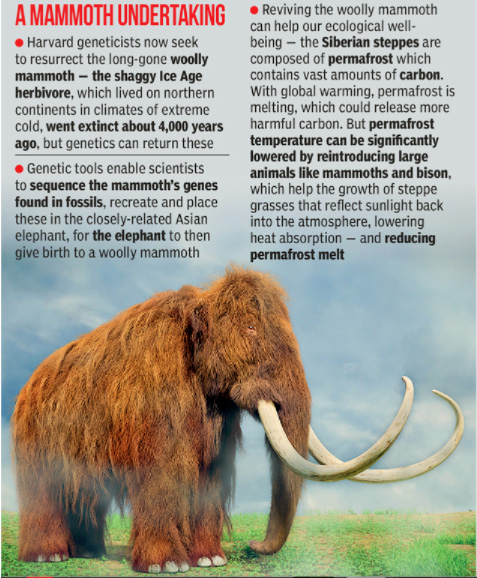Biodiversity & Environment
Woolly Mammoths
- 20 Sep 2021
- 5 min read
Why in News
The United States’ startup Colossal Biosciences has announced its plan to bring woolly mammoths, or animals like them, back from extinction and into the frosty landscape of the Siberian tundra (treeless polar desert).
Key Points
- About:
- Mammoth, (genus Mammuthus), any member of an extinct group of elephants found as fossils in Pleistocene deposits over every continent except Australia and South America and in early Holocene deposits of North America.
- The Pleistocene Epoch began 2.6 million years ago and ended 11,700 years ago.
- The Holocene Epoch began 11,700 years ago and continues through the present.)
- Woolly Mammoths: The woolly, Northern, or Siberian mammoth (Mammuthus primigenius) is by far the best-known of all mammoths.
- The relative abundance and, at times, excellent preservation of this species’s carcasses found in the permanently frozen ground of Siberia has provided much information about mammoths’ structure and habits.
- Cause of Extinction:
- It is believed that mammoths disappeared because of a change in climate, disease, hunting by humans, or perhaps some combination of these.
- Mammoth, (genus Mammuthus), any member of an extinct group of elephants found as fossils in Pleistocene deposits over every continent except Australia and South America and in early Holocene deposits of North America.
- De-extinction of Woolly Mammoths:
- Need:
- Restoration of Ecosystem: When mammoths disappeared from the Arctic some 4,000 years ago, shrubs overtook what was previously grassland.
- Mammoth-like creatures could help restore this ecosystem by compressing shrubs, knocking over trees, and fertilising grasses with their faeces.
- Reduce Climate Change:
- If the current Siberian permafrost melts, it will release potent greenhouse gases.
- De-extinction will prevent the permafrost from melting. Compared to tundra, grassland might reflect more light and keep the ground cooler.
- Restoration of Ecosystem: When mammoths disappeared from the Arctic some 4,000 years ago, shrubs overtook what was previously grassland.
- Technology Used: The CRISPR gene editing technology will be used to modify Asian elephant embryos.
- Asian elephants are the mammoth’s closest living relative so their genomes resemble those of woolly mammoths.
- Need:
- Concerns Raised:
- Disturb the Ecosystem: Bringing back extinct species, whose ecological niches may no longer exist, will upset existing ecosystems.
- Opportunity Cost:
- The de-extinction could distract from more cost-effective efforts to protect biodiversity or mitigate climate change.
- The possible moral hazards that may arise if people start believing extinction is not forever.
- Even if de-extinction programs are successful, they will likely cost more than saving existing species from extinction.
- Once de-extinction becomes possible, the need to protect species from extinction will seem less urgent.
- No Guarantee of Behaviour Adoption: Even if newly engineered mammophants contain mammoth DNA, there is no guarantee these hybrids will adopt the behaviours of ancient mammoths.
- For instance, we inherit more than just DNA sequences from our parents. We inherit epigenetic changes, wherein the environment around us can affect how those genes are regulated.
- We also inherit our parents’ microbiome (colonies of gut bacteria), which plays an important role in our behaviours.
- The behaviours animals learn from observing other members of their species. The first mammophants will have no such counterparts to learn from.
Tundra
- The tundra climate region occurs between 60° and 75° of latitude, mostly along the Arctic coast of North America and Eurasia and on the coastal margins of Greenland.
- Tundra winters are long, dark, and cold, with mean temperatures below 0°C for 6 to 10 months of the year. There is a layer of permanently frozen ground below the surface, called permafrost.
- Structurally, the Tundra is a treeless expanse that supports communities of sedges and heaths as well as dwarf shrubs.








